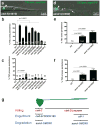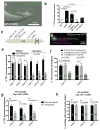EFF-1 fusogen promotes phagosome sealing during cell process clearance in Caenorhabditis elegans
- PMID: 29556089
- PMCID: PMC5876135
- DOI: 10.1038/s41556-018-0068-5
EFF-1 fusogen promotes phagosome sealing during cell process clearance in Caenorhabditis elegans
Abstract
Phagocytosis of dying cells is critical in development and immunity1-3. Although proteins for recognition and engulfment of cellular debris following cell death are known4,5, proteins that directly mediate phagosome sealing are uncharacterized. Furthermore, whether all phagocytic targets are cleared using the same machinery is unclear. Degeneration of morphologically complex cells, such as neurons, glia and melanocytes, produces phagocytic targets of various shapes and sizes located in different microenvironments6,7. Thus, such cells offer unique settings to explore engulfment programme mechanisms and specificity. Here, we report that dismantling and clearance of a morphologically complex Caenorhabditis elegans epithelial cell requires separate cell soma, proximal and distal process programmes. Similar compartment-specific events govern the elimination of a C. elegans neuron. Although canonical engulfment proteins drive cell soma clearance, these are not required for process removal. We find that EFF-1, a protein previously implicated in cell-cell fusion 8 , specifically promotes distal process phagocytosis. EFF-1 localizes to phagocyte pseudopod tips and acts exoplasmically to drive phagosome sealing. eff-1 mutations result in phagocytosis arrest with unsealed phagosomes. Our studies suggest universal mechanisms for dismantling morphologically complex cells and uncover a phagosome-sealing component that promotes cell process clearance.
Figures




Similar articles
-
Visualizing Phagocytic Cargo In Vivo from Engulfment to Resolution in Caenorhabditis elegans.Methods Mol Biol. 2023;2692:337-360. doi: 10.1007/978-1-0716-3338-0_22. Methods Mol Biol. 2023. PMID: 37365478
-
Autophagy mediates phosphatidylserine exposure and phagosome degradation during apoptosis through specific functions of GABARAP/LGG-1 and LC3/LGG-2.Autophagy. 2019 Feb;15(2):228-241. doi: 10.1080/15548627.2018.1512452. Epub 2018 Sep 10. Autophagy. 2019. PMID: 30160610 Free PMC article.
-
Phagocytic receptor CED-1 initiates a signaling pathway for degrading engulfed apoptotic cells.PLoS Biol. 2008 Mar 18;6(3):e61. doi: 10.1371/journal.pbio.0060061. PLoS Biol. 2008. PMID: 18351800 Free PMC article.
-
The developmental and physiological roles of phagocytosis in Caenorhabditis elegans.Curr Top Dev Biol. 2021;144:409-432. doi: 10.1016/bs.ctdb.2020.09.001. Epub 2020 Nov 13. Curr Top Dev Biol. 2021. PMID: 33992160 Review.
-
Phagosome maturation during the removal of apoptotic cells: receptors lead the way.Trends Cell Biol. 2008 Oct;18(10):474-85. doi: 10.1016/j.tcb.2008.08.002. Epub 2008 Sep 4. Trends Cell Biol. 2008. PMID: 18774293 Free PMC article. Review.
Cited by
-
Fusogen-mediated neuron-neuron fusion disrupts neural circuit connectivity and alters animal behavior.Proc Natl Acad Sci U S A. 2020 Sep 15;117(37):23054-23065. doi: 10.1073/pnas.1919063117. Epub 2020 Aug 27. Proc Natl Acad Sci U S A. 2020. PMID: 32855296 Free PMC article.
-
From wound response to repair - lessons from C. elegans.Cell Regen. 2021 Feb 3;10(1):5. doi: 10.1186/s13619-020-00067-z. Cell Regen. 2021. PMID: 33532882 Free PMC article. Review.
-
The AFF-1 exoplasmic fusogen is required for endocytic scission and seamless tube elongation.Nat Commun. 2018 May 1;9(1):1741. doi: 10.1038/s41467-018-04091-1. Nat Commun. 2018. PMID: 29717108 Free PMC article.
-
Cell death in animal development.Development. 2020 Jul 24;147(14):dev191882. doi: 10.1242/dev.191882. Development. 2020. PMID: 32709690 Free PMC article. Review.
-
The endoplasmic reticulum promotes microtubule organization and region-specific disassembly to execute Compartmentalized Cell Elimination.bioRxiv [Preprint]. 2025 May 13:2025.05.08.652974. doi: 10.1101/2025.05.08.652974. bioRxiv. 2025. PMID: 40463001 Free PMC article. Preprint.
References
Publication types
MeSH terms
Substances
Grants and funding
LinkOut - more resources
Full Text Sources
Other Literature Sources
Molecular Biology Databases
Research Materials

